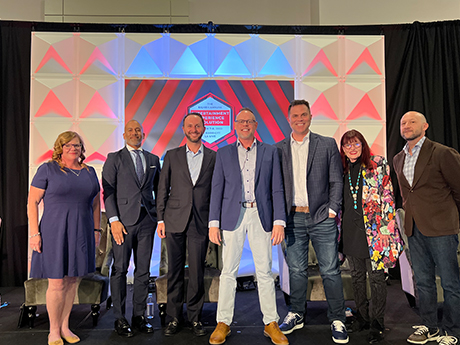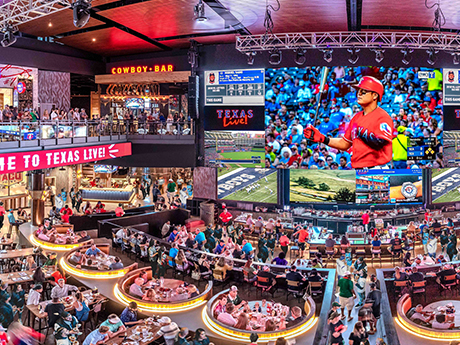LOS ANGELES — As large-scale entertainment districts that are centered around professional sports teams pop up around the country, operators of these developments are realizing that their ability to draw traffic, generate revenue and deliver meaningful experiences goes well beyond the diamond, arena or gridiron.
After all, the average professional sports season only lasts about six months — assuming the team qualifies for the postseason — and only half the games are played at home. Given the scope of these projects, in terms of their vast physical footprints and tremendous manpower needed to operate the wide variety of concepts they house, it follows that sports-anchored entertainment districts cannot rely on athletics alone to be successful.
At the Entertainment Experience Evolution that took place in Los Angeles in early March, a panel of developers and operators with extensive experience in sports-anchored entertainment districts provided concrete examples of how to achieve this objective. Hosted by Shopping Center Business, the flagship publication of Atlanta-based France Media, the event drew more than 500 people in its eighth annual iteration.
Rob Hunden, president and CEO of Hunden Strategic Advisors, a Chicago-based consulting firm for destination-style commercial projects, moderated the discussion.
Pioneering Examples
John Moncke, a former executive at professional soccer club Sporting Kansas City who now serves as president of The Kansas City Power & Light District, was the first panelist to share insights and experiences on the subject. The Cordish Cos., the Maryland-based owner-operator known for the entertainment districts of Major League Baseball’s St. Louis Cardinals and Texas Rangers, also developed The Kansas City Power & Light District.
Moncke’s analysis began with a simple premise that is commonly known among landlords: the experiences that properties create are driven by third-party operators. “That can be a pain point for a lot of landlords, which led us to want to control the experience and control our own concepts,” he said. “To do that, we have to be able to merge and blur the lines between the stadium experience and the development around it.”
The Kansas City Power & Light District has embraced the “live-work-play” mentality that defines true mixed-use developments. In addition to multiple apartment buildings that are situated along the KC Streetcar Line, the downtown development features a coworking concept called Spark that offers an alternative to the existing office buildings.
The various retail stores, restaurants and entertainment venues — including a 1.5 million-square-foot Hard Rock Casino & Hotel — culminate at KC Live! This centerpiece of the district spans a full city block and houses 14 smaller entertainment venues, a central stage with 40-foot screens for Chiefs’ watch parties and numerous flexible spaces for organized parties and events.
Other panelists would echo the importance of smaller entertainment venues — from theaters to concert halls to activated green spaces — in keeping a district popping during athletic downtimes.
Lauren Abernathy, vice president of marketing for the Atlanta Braves Development Co., spoke to this trend at length, using The Battery Atlanta as an exemplary model. The owner of the Braves, Liberty Media Corp., developed the 2.2 million-square-foot mixed-use destination around Truist Park, the team’s ballpark in Cobb County that opened in 2017.
“For 81 days of the year, we’re a sports venue, but we’re equally interested in how we use The Battery outside of sports,” Abernathy said. “For those days, we embrace the pillars of wellness, family and music. We do group outdoor yoga classes, pop-up bars, camps for kids during the summer, farmers markets and traditional holiday events. We also have a 150,000-square-foot space for corporate events.”
Abernathy, who also added that Braves manager Brian Snitker lights the Christmas tree to reinforce the sports connection during the offseason, later cited the 4,000-seat Coca-Cola Roxy Theater as a critical piece of The Battery’s non-sports appeal. “It’s a general admission venue with mezzanine space that does about 150 events per year,” she said. “Those events are built on people having dinner before or drinks afterward, and it works out wonderfully for performers who want to do limited capacity, smaller shows.”
Drew Johnson, director of development at Marquee Development, elaborated on the potential for non-sports-themed events at his company’s flagship development, Gallagher Way, located just outside Wrigley Field in Chicago. Johnson reiterated that Gallagher Way’s branding and identity hinge on the Cubs — the team’s 100,000-square-foot front office facility is located onsite, as is 100,000 square feet of food-and-beverage space that is leased to local operators — before circling back to the non-sports usage.

“We have a 30,000-square-foot public plaza where we host movie nights every Wednesday during the summer when the Cubs aren’t in town,” he said. “We also host about 200 non-gameday events per year, including our Winter Festival, which drew more than 500,000 people to Wrigley Field in the offseason. That was a major accomplishment for us.”
Following the success of Gallagher Way, Marquee Development formed a joint venture with Houston-based real estate giant Hines on North Loop Green in Minneapolis. Situated adjacent to Target Field, home of the Minnesota Twins, North Loop Green consists of 350,000 square feet of office space, 350 market-rate apartments, 17,000 square feet of retail and restaurant space and a one-acre park. The company also recently partnered with soccer club FC Cincinnati to design and build a mixed-use destination that will be located on an 8.5-acre site just outside of TQL Stadium.
Newer Examples
Las Vegas is the undisputed king of entertainment, and Sin City has long since embraced sports as part of its allure, from legalized sports gambling to hosting primetime boxing bouts and marquee events like the Final Four. But the city only recently landed its first professional sports teams — the NFL’s Raiders and the NHL’s Golden Knights — making it something of a newcomer to the world of sports-anchored entertainment districts.
Panelist Julie Brinkerhoff-Jacobs, president of California-based landscape design firm Lifescapes International, has worked on projects in Las Vegas for decades, including with magnate Steve Wynn on his famed Mirage casino and hotel. However, it’s only been in recent months that an opportunity to develop a sports-themed district on the Las Vegas Strip has arisen. The project, known as All Net Resort & Arena, is led by former basketball player and businessman Jackie Robinson.
“The property spans about 27 acres and has about 450,000 square feet of retail, restaurant and entertainment space as well as three hotels, all on the Las Vegas Strip,” explains Brinkerhoff-Jacobs. “Steve Wynn introduced us to Jackie, who he was recruiting to UNLV, and now we’re working on this project.”
All Net is situated between two major casino resorts — The Sahara and Fontainebleu Las Vegas — and will have the capacity to seat about 23,000 spectators. Although progress has been stymied numerous times since the project was originally announced in 2013, vertical construction is now expected to begin this fall, putting the arena on track for a late 2025 completion.
Panelist Michael Belot, a senior vice president with the NBA’s Milwaukee Bucks, also shared insights on a relatively new sports-anchored development: The Deer District. The 30-acre district surrounds Fiserv Forum and features an array of local retail and restaurant operators with distinctly geographic- and sports-themed designs and products.
“As a newcomer to the game, we certainly learned very quickly just how important our programming is,” said Belot, who like Abernathy with the Braves, holds an executive position with the real estate development and operations arm of the team. “We can operate independently and attract people regardless of what’s going on in the arena, from Bloody Mary festivals to Christmas events to fitness classes.”
Some phases of development at The Deer District are still ongoing, and a new hotel will open at the site later this year. The team has also partnered with concert promoters LiveNation and Frank Productions on the development of two new music venues. Construction began in April, and Belot projects that both of those facilities will allow The Deer District to host between 125 to 150 new music events on an annual basis.
Summarizing the Takeaway
Moderator Hunden wrapped up this segment of the dialogue by reiterating the importance of ancillary events and programming in establishing sports-anchored districts as legitimate destinations that draw people in during all times of the year.
“In terms of non-major-sporting events, all of you have to make your bread and butter with smaller activations throughout the year,” he said. “Identifying the secret sauce, experiencing a learning curve and figuring out how to keep these developments busy when it’s offseason is what it’s all about.”
“Sometimes you think you know what the secret to activating a development is and what will work for your property, but you’re not going to get it right every time,” said Abernathy. “With the marketing and the tenanting of the space, everything has to coexist around whatever the elephant in the room is, which for us is sports. But ultimately, it’s not about filling the space so much as it is extending the stay.”
“With these entertainment districts, we want to be able to control our own destiny,” concurred panelist Todd Goldstein, chief revenue officer of Anschutz Entertainment Group, which owns the Crypto.com arena (formerly known as the Staples Center) in downtown Los Angeles. The company launched the L.A. Live! entertainment district that surrounds the arena in 2007, when both the NBA’s Los Angeles teams played there (beginning with the 2024-2025 season, the Clippers will play in a newly constructed arena in Inglewood).
“We’ve spent billions on these teams and their venues, but you also want people to come when the team isn’t in session,” Goldstein continued. “By controlling the look, feel and event lineup at the property, and by integrating sponsors and brands into these districts, you create huge energy and momentum and joy. And as often as not, the teams win titles too.”
— Taylor Williams


